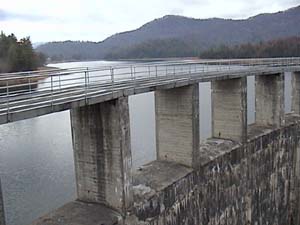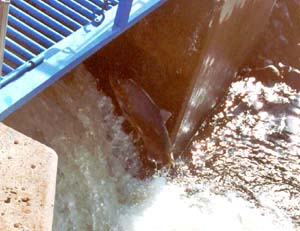How Dams Impact Rivers
Dams impact rivers in a variety of ways. One of the best ways to understand these impacts is to explore them in each section of a dammed river from upstream to downstream. These sections are: the Upstream River Reach, the Reservoir, the Bypass Reach (if there is one), and the Downstream River reach. Dams impact each of these areas differently and essentially chop up what was once continuous habitat into these three or four distinct pieces. For a visual overview of impacts visit Dam Effects website.
Upstream River Reach
All reservoirs have water flowing into them, usually from the river that was dammed and also the various tributaries that used to enter the river but now flow into the reservoir. These river reaches are essentially isolated from the original river - and become ecological islands of habitat. Reservoirs provide very different habitat than rivers, and often stream organisms are unable to live in or even safely move through reservoirs due to exposure to predators, different water quality/temperature variables, or simply the lack of current. Dams impact these upstream reaches in the following ways:
- Upstream reaches are no longer connected to the main river or to each other by continuous inhabitable habitat.
- Populations of aquatic organisms may become fragmented into multiple smaller subpopulations that experience less exchange of genetic material with fewer other individuals - making them more subject to localized extinctions.
- Upstream watersheds are often deprived of migratory fish and their resulting social and ecological benefits which include the inherent value of the continuation of the migratory fish species, nutrient contributions to the aquatic, riparian and even upland areas, utilization by animals as a food source, utilization by people for sport fishing, food, and commerce, and the spiritual value of the return of the fish.
The Reservoir
Often overlooked because they are hidden under a glimmering reservoir - the ecological impacts of the reservoir itself are the most dramatic impacts of all sections of a dammed river. Construction of reservoirs completely converts terrestrial ecosystems complete with rivers and streams flowing through them, into submerged and still water aquatic ecosystems. Certainly all terrestrial organisms flee the rising water as the reservoir originally fills - or perish. The following is a summary of the ecological impacts of reservoirs themselves.
- Terrestrial and ecologically valuable riparian is habitats are completely submerged and lost to the plant and animal species that previously inhabited them. Many plants and animals perish at the time of initial reservoir filling.
- Reservoirs form new barriers to terrestrial animal movements and migrations.
- The land submerged under reservoirs is subject to erosion, physical and chemical changes, and filing in with sediment.
- Newly filled reservoirs have been shown to release significant amounts of mercury.
- Dams typically act as absolute barriers to upstream fish migration and movement, unless fish passage facilities have been installed. Many fish passage facilities pass only some percentage - often a small one - of fish that reach the dam.
- Reservoirs are very different ecosystems than rivers, and are therefore typically inhabited by different organisms. The construction of reservoirs creates new habitat conditions that are generally hostile to native stream fishes while they may be suitable for introduced fishes and other organisms, or may artificially select for native species that can live in the reservoirs.
- Small migratory fish such as salmon that typically float downstream to the ocean are radically slowed or stopped by reservoirs - making them subject to predation and other causes of mortality.
- Fish attempting to pass downstream of a dam may be blocked entirely or pulled through the turbines of the hydroelectric unit which may or may not kill the fish. Stunned fish that do pass the dam are subject to increased predation by birds and other fish.
- Reservoirs often flood inhabited lands that must be evacuated. Often, deep social scars are left by this process that last for generations.
- Reservoirs may increase land values around their shorelines and therefore may lead to increased development and social changes to these often rural areas.
- All river recreation and terrestrial recreational opportunities under reservoirs are obviously lost for lifetimes - and replaced by reservoir based recreation opportunities.
The Bypass Reach
Many dams divert water for some distance to a powerhouse through a pipe, tunnel, or flume. This process radically increases the head (height the water is dropped from) at a relatively low construction cost, and therefore greatly increases the profitability of the dam. The problem with this process is that it generally leaves the section of river parallel to the diversion dry or close to it. These river reaches, located between a dam and its powerhouse are known as bypass reaches because the water is bypassed around them. Most bypass reaches are high gradient rivers and streams that feature - or at least used to feature - excellent whitewater opportunities. Bypass reaches have some very serious ecological problems that are often a restoration focus during dam relicensings. The ecological impacts associated with bypass reaches are as follows:
- The ecology of bypass reaches can be described as “Hell or High Water.” The reaches typically flow at very low flows as provided by leakage, groundwater discharge, tributary inflow, or a mandatory minimal release from the dam - or they infrequently flow at very high flows that result from the dams having to spill water due to unusually high inflow.
- Low flow conditions eliminate the quantity and quality of the aquatic habitat available for aquatic species.
- Water quality and temperature are often impacted by low flow conditions.
- Riparian vegetation encroaches into the river channel as the ecosystem seeks to establish a smaller redefined stream channel bordered by terrestrial habitat.
- High flows periodically scour vegetation, aquatic organisms, and sediment from the channel and essentially reset the ecosystem.
- Disturbance adapted species, often exotic, are artificially selected to live in the channel while many species that have not evolved mechanisms to deal with radically low and high flows may disappear from the channel.
- In cases where the flow has been greatly reduced, the aquatic habitat and species composition may more closely resemble a chain of small pools and wetlands than a river.
- Often, boatable flows are seldom or never encountered in bypass reaches unless intentionally provided because low flows are too low and the spills are too high. Therefore, bypass reaches impact paddling by virtually eliminating it.
- Sometimes bypass reaches do support angling opportunities - largely based on angling preferences for low flow conditions. At times a class IV or V river will be turned into a trickle that allows wading. Thus, the recreational characteristics of the bypass reach has been altered.
- Often, bypass reaches are virtually forgotten by nearby residents.
The Cheoah River in Western North Carolina has a good example of a bypass reach. For more information, visit Dam Impacts–Examples
The Downstream River Reach
The majority of research into regulated river restoration has focused on the downstream impacts of dams and how to limit and mitigate those impacts. This is simply because all dams impact rivers downstream, the downstream length of impact is fairly long, the downstream habitat is often the most viable, and because changes in dam operations can make or break the downstream ecosystem. The basic downstream impacts of dams are as follows:
- The flow regime is altered by most dams. Large storage dams have virtually complete control over a rivers flow regime and can manipulate flows to provide profit or other social goals. Smaller dams with less storage have less ability to control the flow regime but most still can essentially turn a river on and off at will for periods of time.
- Altered flow regimes can change aquatic species composition, diversity, and distribution.
- Altered flow regimes can lead to changes in riparian and floodplain vegetation by providing an unnaturally consistent flow regime, and by eliminating regular out of bank flows and large floods.
- Altered flow regimes can greatly change recreational patterns and characteristics.
- Altered flow regimes can encourage industrial use of the river, and floodplain building.
- The sediment regime is altered by most dams because reservoirs typically trap sediment flowing into them from upstream, leaving the downstream reaches sediment starved. This condition can lead to changes in the stream's bed, banks, and floodplain. It can also lead to nutrient based ecological changes in the river.
- The water temperature regime below dams is typically altered and is largely determined by the depth from which the release water is pulled from the reservoir. Deeper water is typically colder. Cold water, when released into naturally warm or cool water ecosystems can have devastating impacts on natural fish and mussel populations. Many organisms have evolved with a specific temperature regime and are ill suited to adapt to an altered one.
- Several water quality parameters are also heavily altered by dams including dissolved oxygen which can be drastically lowered by dams.
- Downstream fish and other aquatic organisms' populations are generally fragmented by dams. Many fish and other species literally bump their heads on the dams and can move no further upstream. These organisms are cut off from upstream habitat, while forced to live in degraded downstream habitat. In the case of migratory such like salmon this condition often spells disaster for upstream fish runs, the people and organisms that depend on those runs, and at times the species as a whole.
Klamath River Salmon jumps its last jump at the base of the downstream-most dam on the river. This salmon may be artificially bred - and will then be used for fertilizer and food. Salmon do not pass the Klamath's dams.
The Nantahala River is a good example of a river that has downstream impacts from hydropower. For more information, visit Dam Impacts–Examples.
Additional Resources
Several other excellent resources are available for learning about the impacts of dams on rivers. American Whitewater recommends the following resources.
The USGS has published an excellent free book called Dams and Rivers: A Primer on the Downstream Effects of Dams (Circular 1126). A copy of the book can be obtained by ordering it online at the USGS Store, which will require a nominal shipping fee. You may also view the book online at: http://pubs.er.usgs.gov/pubs/cir/cir1126.
If you want to get really in depth the US Forest Service now offers a free online short course called the Geomorphic Response of Rivers to Dams. The course is essentially a video shot of several talks given in March of 2003 that includes a power-point panel on your computer screen. Check it out at: http://www.fsl.orst.edu/geowater/morphology/
How Hydropower Works (Source: U.S. Department of Energy)
Hydropower plants capture the kinetic energy of falling water to generate electricity. Hydropower produces about 11 percent of our nation's energy. The Department of Energy provides an informative webpage explaining how hydropower works.
Hydropower's Impacts on Rivers (Source: Hydropower Reform Coalition)
Developed by the Hydropower Reform Coalition, Hydropower's Impacts on Rivers provides information about hydropower generation hurts rivers, and contains links to more information about efforts to reform hydro.
Scientific Literature
Coming Soon


